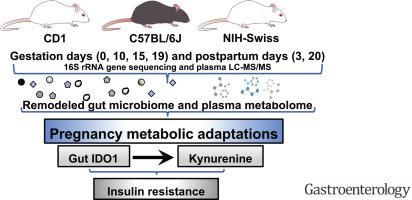Gastroenterology ( IF 29.4 ) Pub Date : 2022-01-13 , DOI: 10.1053/j.gastro.2022.01.008 Medha Priyadarshini 1 , Guadalupe Navarro 1 , Derek J Reiman 2 , Anukriti Sharma 3 , Kai Xu 1 , Kristen Lednovich 1 , Christopher R Manzella 4 , Md Wasim Khan 1 , Mariana Salas Garcia 5 , Sarah Allard 5 , Barton Wicksteed 1 , George E Chlipala 6 , Barbara Szynal 1 , Beatriz Penalver Bernabe 2 , Pauline M Maki 7 , Ravinder K Gill 4 , Gary H Perdew 8 , Jack Gilbert 9 , Yang Dai 2 , Brian T Layden 10

|
Background & aims
Normal gestation involves a reprogramming of the maternal gut microbiome (GM) that contributes to maternal metabolic changes by unclear mechanisms. This study aimed to understand the mechanistic underpinnings of the GM—maternal metabolism interaction.
Methods
The GM and plasma metabolome of CD1, NIH-Swiss, and C57 mice were analyzed with the use of 16S rRNA sequencing and untargeted liquid chromatography–mass spectrometry throughout gestation. Pharmacologic and genetic knockout mouse models were used to identify the role of indoleamine 2,3-dioxygenase (IDO1) in pregnancy-associated insulin resistance (IR). Involvement of gestational GM was studied with the use of fecal microbial transplants (FMTs).
Results
Significant variation in GM alpha diversity occurred throughout pregnancy. Enrichment in gut bacterial taxa was mouse strain and pregnancy time point specific, with the species enriched at gestation day 15/19 (G15/19), a point of heightened IR, being distinct from those enriched before or after pregnancy. Metabolomics revealed elevated plasma kynurenine at G15/19 in all 3 mouse strains. IDO1, the rate-limiting enzyme for kynurenine production, had increased intestinal expression at G15, which was associated with mild systemic and gut inflammation. Pharmacologic and genetic inhibition of IDO1 inhibited kynurenine levels and reversed pregnancy-associated IR. FMT revealed that IDO1 induction and local kynurenine level effects on IR derive from the GM in both mouse and human pregnancy.
Conclusions
GM changes accompanying pregnancy shift IDO1-dependent tryptophan metabolism toward kynurenine production, intestinal inflammation, and gestational IR, a phenotype reversed by genetic deletion or inhibition of IDO1. (Gestational Gut Microbiome–IDO1 Axis Mediates Pregnancy Insulin Resistance; EMBL-ENA ID: PRJEB45047. MetaboLights ID: MTBLS3598)
中文翻译:

妊娠期胰岛素抵抗是由肠道微生物组-吲哚胺 2,3-双加氧酶轴介导的
背景和目标
正常妊娠涉及母体肠道微生物组 (GM) 的重新编程,通过尚不清楚的机制导致母体代谢变化。本研究旨在了解 GM 与母体代谢相互作用的机制基础。
方法
在整个妊娠期间,使用 16S rRNA 测序和非靶向液相色谱-质谱法分析 CD1、NIH-Swiss 和 C57 小鼠的 GM 和血浆代谢组。使用药理学和基因敲除小鼠模型来确定吲哚胺 2,3-双加氧酶 (IDO1) 在妊娠相关胰岛素抵抗 (IR) 中的作用。利用粪便微生物移植 (FMT) 研究了妊娠期 GM 的参与情况。
结果
GM α 多样性在整个怀孕期间发生显着变化。肠道细菌类群的富集是针对小鼠品系和妊娠时间点的,其中物种在妊娠第 15/19 天(G15/19)富集,这是一个 IR 升高的点,与怀孕之前或之后富集的物种不同。代谢组学显示,所有 3 种小鼠品系在 G15/19 时血浆犬尿氨酸均升高。IDO1 是犬尿氨酸产生的限速酶,在 G15 时肠道表达增加,这与轻度全身和肠道炎症有关。IDO1 的药理学和遗传抑制可抑制犬尿氨酸水平并逆转妊娠相关的 IR。FMT 揭示了 IDO1 诱导和局部犬尿氨酸水平对 IR 的影响源自小鼠和人类妊娠中的 GM。
结论
伴随怀孕的 GM 变化将 IDO1 依赖性色氨酸代谢转变为犬尿氨酸产生、肠道炎症和妊娠 IR,这是一种通过 IDO1 基因删除或抑制而逆转的表型。(妊娠肠道微生物组 –IDO1 轴介导妊娠期胰岛素抵抗;EMBL-ENA ID:PRJEB45047。MetaboLights ID:MTBLS3598)


























 京公网安备 11010802027423号
京公网安备 11010802027423号